
Thameslink is a 24-hour main-line route in the British railway system, running from Bedford, Luton, St Albans City, Peterborough and Cambridge via central London to Sutton, Orpington, Sevenoaks, Rainham, Horsham, Brighton and East Grinstead. The network opened as a through service in 1988, with severe overcrowding by 1998, carrying more than 28,000 passengers in the morning peak. All the services are currently operated by Govia Thameslink Railway.
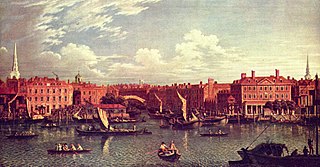
The River Fleet is the largest of London's subterranean rivers, all of which today contain foul water for treatment. It has been used as a sewer since the development of Joseph Bazalgette's London sewer system in the mid 19th century with the water being treated at Beckton Sewage Treatment Works. Its headwaters are two streams on Hampstead Heath, each of which was dammed into a series of ponds—the Hampstead Ponds and the Highgate Ponds—in the 18th century. At the southern edge of Hampstead Heath these descend underground as sewers and join in Camden Town. The waters flow 4 miles (6 km) from the ponds.

Elephant and Castle is an area of South London, England, in the London Borough of Southwark. The name also informally refers to much of Walworth and Newington, due to the proximity of the London Underground station of the same name. The name is derived from a local coaching inn.

King's Cross Thameslink station is a closed railway station in central London, England. It is located on Pentonville Road, around 250 metres (0.2 mi) east of King's Cross mainline station. At the time of closure, in 2007, it was served by Thameslink trains and managed by First Capital Connect. Services have been transferred to a new station underneath St Pancras.

Blackfriars, also known as London Blackfriars, is a central London railway station and connected London Underground station in the City of London. It provides Thameslink services: local, and regional and limited Southeastern commuter services to South East London and Kent. Its platforms span the River Thames, the only one in London to do so, along the length of Blackfriars Railway Bridge, a short distance downstream from Blackfriars Bridge. There are two station entrances either side of the Thames, along with a connection to the London Underground District and Circle lines.

City Thameslink is a central London railway station within the City of London, with entrances on Ludgate Hill and Holborn Viaduct. The station is on the Thameslink route between Blackfriars to the south and Farringdon to the north.

Holborn Viaduct is a road bridge in London and the name of the street which crosses it. It links Holborn, via Holborn Circus, with Newgate Street, in the City of London, England financial district, passing over Farringdon Street and the subterranean River Fleet. The viaduct spans the steep-sided Holborn Hill and the River Fleet valley at a length of 1,400 feet (430 m) and 80 feet (24 m) wide. City surveyor William Haywood was the architect and the engineer was Rowland Mason Ordish.

Herne Hill railway station is in the London Borough of Lambeth, South London, England, on the boundary between London fare zones 2 and 3. Train services are provided by Thameslink to London Blackfriars, Farringdon, St Pancras International and St Albans on the Thameslink route and by Southeastern to London Victoria and Orpington on the Chatham Main Line. It is 3 miles 76 chains (6.4 km) down the line from Victoria.
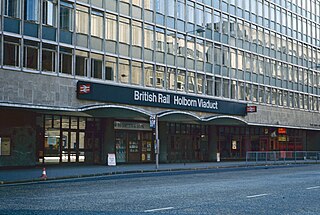
Holborn Viaduct was a railway station in the City of London, providing local and commuter services. It was located to the southeast of Holborn Viaduct, and east of Farringdon Street.
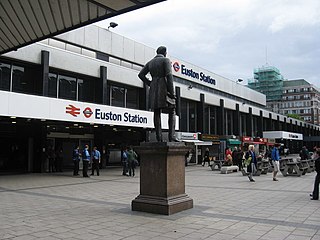
The London station group is a group of 18 railway stations served by the National Rail network in central London. The group contains all 14 terminal stations in central London, either serving major national services or local commuter routes, and 4 other through-stations that are considered terminals for ticketing purposes. All current stations in the group fall within London fare zone 1. A ticket marked "London Terminals" allows travel to any station in the group via any permitted route, as determined by the National Routeing Guide.

Ludgate Hill was a railway station in the City of London that was opened on 1 June 1865 by the London, Chatham and Dover Railway (LC&DR) as its City terminus. It was on Ludgate Viaduct between Queen Victoria Street and Ludgate Hill, slightly north of St. Paul's station on the site of the former Fleet Prison.

Ludgate Circus is a road junction in the City of London where Farringdon Street/New Bridge Street crosses Fleet Street/Ludgate Hill.
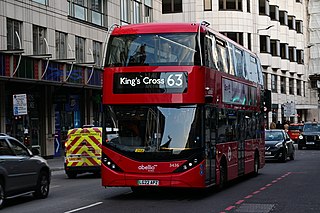
London Buses route 63 is a Transport for London contracted bus route in London, England. Running between Honor Oak and King's Cross station, it is operated by Abellio London.

The Thameslink Programme, originally Thameslink 2000, was a £6 billion project in south-east England to upgrade and expand the Thameslink rail network to provide new and longer trains between a wider range of stations to the north and to the south of London. The development facilitated new cross-London journeys, which means that passengers no longer have to change trains in London. Work included platform lengthening, station remodelling, new railway infrastructure, and new rolling stock. The project was originally proposed in 1991 following the successful introduction of the initial Thameslink service in 1988. After many delays, planning permission was granted in 2006 and funding was approved in October 2007. Work started in 2009 and was completed on 18 September 2020, although trains over the new routes began running in 2018.
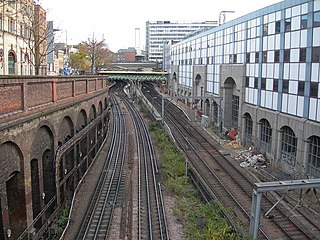
The Widened Lines is a double-track railway line forming part of the Thameslink route between St Pancras and Farringdon within Central London.

Angel is an area on the northern fringes of Central London within the London Borough of Islington. It is 2 miles (3.2 km) north-northeast of Charing Cross on the Inner Ring Road at a busy transport intersection. The area is identified in the London Plan as one of 35 major centres in London. It is a significant commercial and retail centre, and a business improvement district. Angel straddles the ancient boundary of the parishes of Clerkenwell and Islington that later became the metropolitan boroughs of Finsbury and Islington. It is named from the former Angel Inn which stood on the corner of Islington High Street and Pentonville Road. Since 1965 the whole area has formed part of the London Borough of Islington in Greater London.

The Royal Commission on London Traffic was a Royal commission established in 1903 with a remit to review and report on how transport systems should be developed for London and the surrounding area. It produced a report in eight volumes published in 1905 and made recommendations on the character, administration and routing of traffic in London.

The Holborn Viaduct–Herne Hill line is a railway line between Holborn Viaduct in the City of London and Herne Hill in the London Borough of Lambeth. After the closure of Holborn Viaduct station the line ends at the south portal of Snow Hill tunnel merging into Snow Hill lines. From there the Widened Lines to St Pancras and Kentish Town are reached. Today the section north of Blackfriars is part of the Thameslink core. Originally being a branch line of the London, Chatham and Dover Railway (LCDR) towards the City of London, the line is sometimes called LCDR City Branch.

The Royal Commission to Investigate the Various Projects for Establishing Railway Termini Within or in the Immediate Vicinity of the Metropolis was a Royal commission established in 1846 with a remit to review and report on railway termini in London.




















